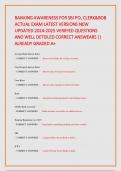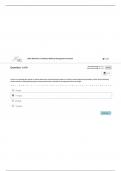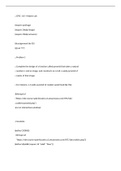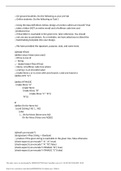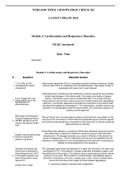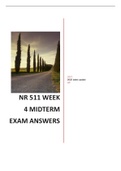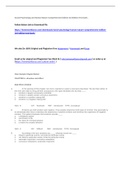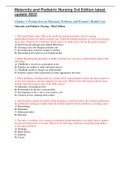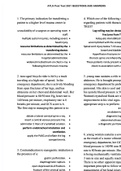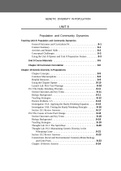University Of Columbia
Latest uploads at University Of Columbia. Looking for notes at University Of Columbia? We have lots of notes, study guides and study notes available for your school.
-
32
- 0
-
1
All courses for University Of Columbia
- HESI COMPREHENSION EXAM 1 HESI COMPREHENSION EXAM 1 1
- HESI COMPREHENSION EXAM 2 HESI COMPREHENSION EXAM 2 1
- HESI COMPREHENSION EXAM 3 HESI COMPREHENSION EXAM 3 1
- HESI COMPREHENSION EXAM 4 HESI COMPREHENSION EXAM 4 2
- HLT 306V Topic 4 Quiz with Answers HLT 306V 2
- HLT 306V Topic 5 Quiz with Answers 1
- HLT 306V Topic 5 Quiz with Answers Set 2 1
- HSC MISC 2
Latest notes & summaries University Of Columbia
BANKING AWARENESS FOR SBI PO, CLERK&BOB ACTUAL EXAM LATEST VERSIONS NEW UPDATED VERIFIED QUESTIONS AND WELL DETEILED CORRECT ANSWEARS || ALREADY GRADED A+ BANKING AWARENESS FOR SBI PO, CLERK&BOB ACTUAL EXAM LATEST VERSIONS NEW UPDATED VERIFIED QUESTIONS AND WELL DETEILED CORRECT ANSWEARS || ALREADY GRADED A+ BANKING AWARENESS FOR SBI PO, CLERK&BOB ACTUAL EXAM LATEST VERSIONS NEW UPDATED VERIFIED QUESTIONS AND WELL DETEILED CORRECT ANSWEARS || ALREADY GRADED A+
ATI MED SURG SKILLS MODULE DIABETES MELLITUS MANAGEMENT POSTTEST ASSESSMENT EXAM NGN
(require spd/tags) (require 2htdp/image) (require 2htdp/universe) (@assignment lab-05) (@cwl ???) ;; Problem 1 ;; Complete the design of a function called pyramid that takes a natural ;; number n and an image, and constructs an n-tall, n-wide pyramid of ;; copies of that image. ;; For instance, a 3-wide pyramid of cookies would look like this: ;(bitmap/url ;" ; ") ;(run in interactions window)
;; On-ground students: Do the following as your pre-lab ;; Online students: Do the following as Task 1 ;; Using the data definitions below, design a function called can-encode? that ;; takes a letter (NOT an entire word) and a Huffman code tree and ;;produces true ;; if that letter is reachable in the given tree, false otherwise. You should ;; not use any accumulators. As a reminder, we have asked you to blend the ;; backtracking template into your design. ;; We have provided the signatu...
NURS 6501 WEEK 3 KNOWLEDGE CHECK M2 LATEST UPDATE 2022
1. Define diagnostic reasoning Reflective thinking because thhe process involves questioning one's thinking to determine if all possible avenues have been explored & if thhe conclusions that are being drawn are based on evidence. Seen as a kind of critical thinking. 2. What is subjective data? Anything thhe patient tells you or complains of regarding thheir symptoms Chief complaint HPI ROS 3. What is objective data? Anything YOU can see, touch, feel, hear, or smell as part of yo...
1. In the opening of this chapter, two men’s reactions to spam e-mail were described. The fact that neither of the men were able to shrug off their annoyance to the spam illustrates the fact that ____. a. emotion is largely consciously controlled b. emotion is largely outside conscious awareness c. emotion is a positive coping skill d. emotion is a negative coping skill ANS: B DIF: Moderate REF: Introduction TYPE: Conceptual 2. Emotions are both positive and negative. Once people experi...
Chapter 1- Perspectives on Maternal, Newborn, and Women’s Health Care Maternity and Pediatric Nursing - Third Edition 1. The United States ranks 50th in the world for maternal mortality and 41st among industrialized nations for infant mortality rate. When developing programs to assist in decreasing these rates, which factor would most likely need to be addressed as having the greatest impact? A) Resolving all language and cultural differences B) Assuring early and adequate prenatal care ...
1. The primary indication for transferring a patient to a higher level trauma center is:patient to a higher level trauma center is: unavailability of a surgeon or operating roomunavailability of a surgeon or operating room . multiple system injuries, including severemultiple system injuries, including severe head injury. resource limitations as determined by theresource limitations as determined by the transferring ferring doctor. resource limitations as determin...
UNIT 8 Population and Community Dynamics Teaching Unit 8: Population and Community Dynamics General Outcomes and Curriculum Fit . . . . . . . . . . . . . . . . . . . . . . . 8-1 Content Summary . . . . . . . . . . . . . . . . . . . . . . . . . . . . . . . . . . . . . . . 8-1 Activities and Related Skills . . . . . . . . . . . . . . . . . . . . . . . . . . . . . . . . 8-2 Conceptual Challenges . . . . . . . . . . . . . . . . . . . . . . . . . . . . . . . . . . . 8-3 Using the Unit 8 Opener...

